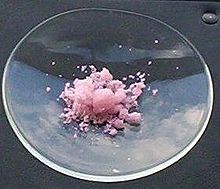Erbium(III) chloride

| |
| Names | |
|---|---|
| IUPAC name
Erbium(III) chloride
| |
| Other names
Erbium trichloride
| |
| Identifiers | |
3D model (JSmol)
|
|
| ChemSpider | |
| ECHA InfoCard | 100.030.337 |
PubChem CID
|
|
CompTox Dashboard (EPA)
|
|
| |
| |
| Properties | |
| ErCl3 (anhydrous) ErCl3·6H2O (hexahydrate) | |
| Molar mass | 273.62 g/mol (anhydrous) 381.71 g/mol (hexahydrate) |
| Appearance | violet hygroscopic monoclinic crystals (anhydrous) pink hygroscopic crystals (hexahydrate) |
| Density | 4.1 g/cm3 (anhydrous) |
| Melting point | 776 °C (1,429 °F; 1,049 K) |
| Boiling point | 1,500 °C (2,730 °F; 1,770 K) |
| soluble in water (anhydrous) slightly soluble in ethanol (hexahydrate)[1] | |
| Related compounds | |
Other anions
|
Erbium(III) oxide |
Other cations
|
Holmium(III) chloride, Thulium(III) chloride |
Except where otherwise noted, data are given for materials in their standard state (at 25 °C [77 °F], 100 kPa).
| |
Erbium(III) chloride, the erbium(III) salt of hydrochloric acid, is a violet solid used for the preparation of erbium metal.
Properties

It is also found as a pink crystalline hexahydrate, CAS number [10025-75-9]. It has the interesting property that the pink colour is much more intense under the light from a fluorescent lamp, as may be seen from the picture.
Anhydrous erbium(III) chloride is formed from the hexahydrate by heating under a strongly chlorinating atmosphere, such as chlorine or hydrogen chloride; otherwise erbium oxide chloride, ErOCl, is formed. An alternative preparation is to react the readily available Er2O3 with excess NH4Cl to make the intermediate salt (NH4)3ErCl6 plus both ammonia and water. This salt is stable with respect to hydrolysis and can be thermally decomposed under vacuum to yield anhydrous erbium(III) chloride with loss of ammonia and gaseous HCl.
It reacts with alkalis to form erbium(III) hydroxide:
ErCl3 + 3 XOH → Er(OH)3 + 3 XCl
Structural data
Erbium chloride forms crystals of the AlCl3 type, with monoclinic crystals and the point group C2/m.[2]
Erbium(III) chloride hexahydrate also forms monoclinic crystals with the point group of P2/n (P2/c) - C42h. The erbium is octa-coordinated to form [Er(H2O)6Cl2]+ ions with the isolated Cl− completing the structure.[3]
Optical properties
Erbium(III) chloride solutions show a negative nonlinear absorption effect.[4]
Catalytic properties
Erbium(III) chloride is a powerful catalyst for the acylation of alcohols and phenols, and can be easily recycled and reused without significant loss of activity.[5]
References
- ^ Lide, David R. (1998). Handbook of Chemistry and Physics (87 ed.). Boca Raton, FL: CRC Press. pp. 4–57. ISBN 0-8493-0594-2.
- ^ Tempelton DH, Carter GF (1954). "The Crystal Structure of Yttrium Trichloride and Similar Compounds". J Phys Chem. 58 (11): 940–943. doi:10.1021/j150521a002.
- ^ Graebner EJ, Conrad GH Duliere SF (1966). "Crystallographic data for solvated rare earth chlorides". 21: 1021.
{{cite journal}}: Cite journal requires|journal=(help) - ^ Maeda Y, Akidzuki Y, Yamada T (1998). "All-optical liquid device derived from negative nonlinear absorption effect in an erbium chloride solution". Applied Physics Letters. 73 (17): 2411–2413. doi:10.1063/1.122450.
{{cite journal}}: CS1 maint: multiple names: authors list (link) - ^ CSIRO PUBLISHING - Australian Journal of Chemistry
